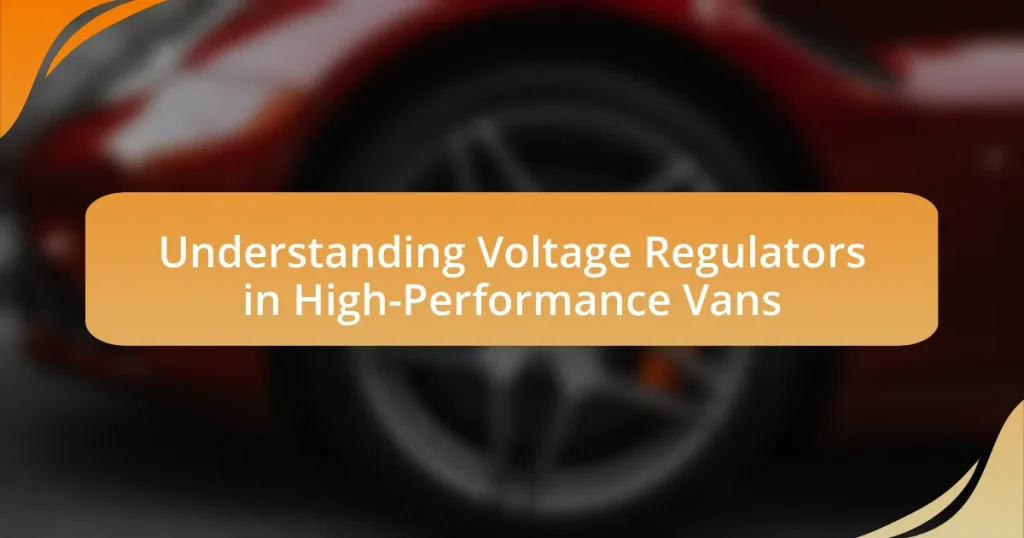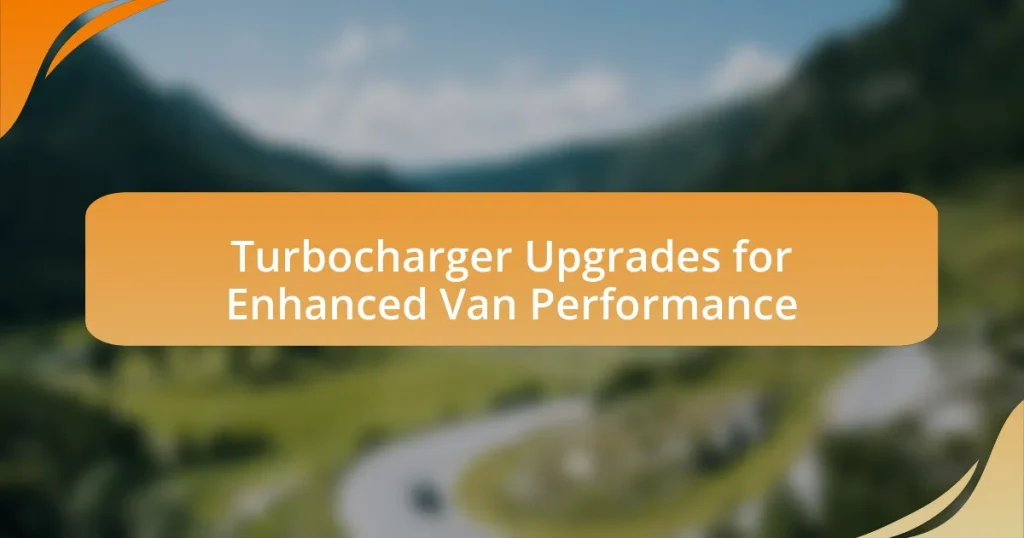Voltage regulators are essential electronic devices that maintain a stable voltage level in high-performance vans, ensuring the efficient operation of complex electrical systems. This article explores the functionality of voltage regulators, detailing their key components, types, and the critical role they play in enhancing vehicle performance and efficiency. It also examines the impact of voltage regulation on engine performance, fuel efficiency, and the longevity of electrical systems, while providing best practices for maintenance and troubleshooting. Understanding these aspects is crucial for optimizing the reliability and performance of high-performance vans.
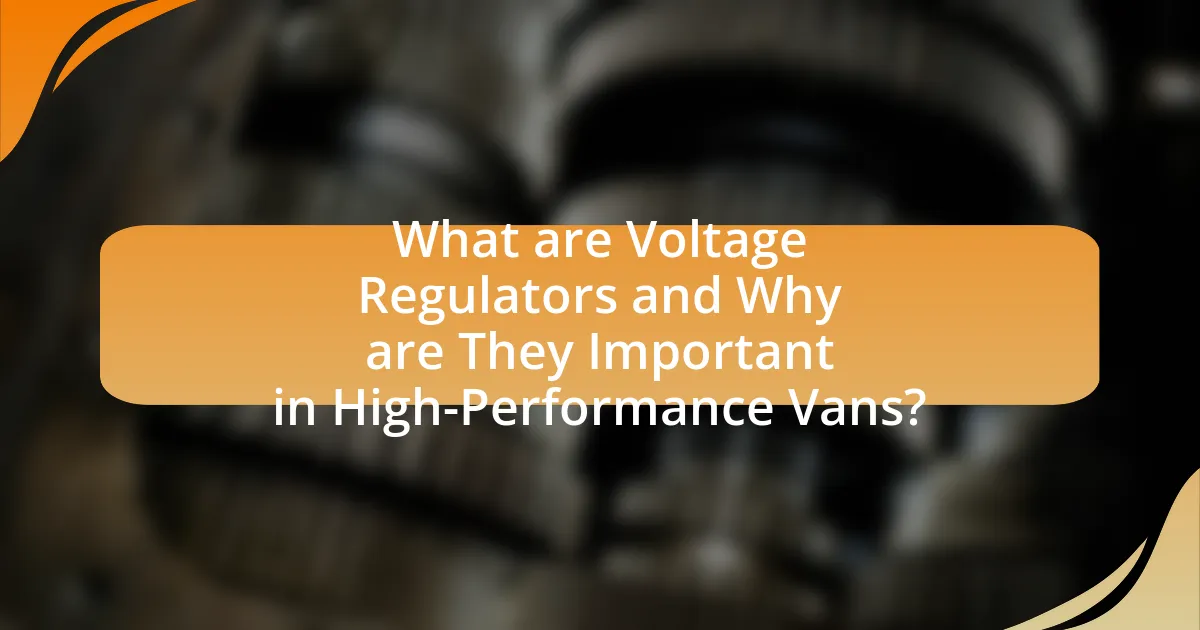
What are Voltage Regulators and Why are They Important in High-Performance Vans?
Voltage regulators are electronic devices that maintain a constant voltage level to ensure the proper functioning of electrical systems in high-performance vans. They are crucial because high-performance vans often have complex electrical systems that require stable voltage to operate efficiently, preventing damage to sensitive components and ensuring optimal performance. For instance, fluctuations in voltage can lead to malfunctions in the engine control unit, infotainment systems, and other critical electronics, which can compromise the vehicle’s performance and safety.
How do Voltage Regulators function in high-performance vehicles?
Voltage regulators in high-performance vehicles maintain a consistent voltage level to ensure optimal operation of electrical components. They achieve this by adjusting the output voltage based on the varying demands of the vehicle’s electrical system, which can fluctuate due to changes in engine speed and load conditions. For instance, when the engine operates at higher RPMs, the alternator generates more voltage; the voltage regulator prevents this excess voltage from damaging sensitive electronic components by reducing the output to a safe level, typically around 13.5 to 14.5 volts. This regulation is crucial in high-performance vehicles, where advanced electronics and systems require stable voltage for peak performance and reliability.
What are the key components of a voltage regulator?
The key components of a voltage regulator include a reference voltage source, an error amplifier, a pass element, and feedback circuitry. The reference voltage source provides a stable voltage against which the output voltage is compared. The error amplifier processes the difference between the output voltage and the reference voltage, generating a control signal. The pass element, typically a transistor, regulates the output voltage by adjusting its resistance based on the control signal. Finally, feedback circuitry ensures that the output voltage remains stable by continuously monitoring and adjusting the system. These components work together to maintain a consistent output voltage, which is crucial for the reliable operation of electronic systems in high-performance vans.
How does the voltage regulation process work?
The voltage regulation process works by maintaining a constant output voltage despite variations in input voltage or load conditions. Voltage regulators achieve this by using feedback mechanisms that monitor the output voltage and adjust the input or control elements accordingly. For instance, in linear voltage regulators, a variable resistor adjusts the resistance to keep the output voltage stable, while in switching regulators, the process involves rapidly switching the input voltage on and off to control the output voltage. This regulation is crucial in high-performance vans to ensure that sensitive electronic components receive a stable voltage, preventing damage and ensuring optimal performance.
What types of voltage regulators are commonly used in high-performance vans?
Commonly used voltage regulators in high-performance vans include linear voltage regulators and switching voltage regulators. Linear voltage regulators provide a stable output voltage with low noise, making them suitable for sensitive electronic components. In contrast, switching voltage regulators are more efficient, especially under varying load conditions, and are preferred for applications requiring higher power efficiency. These types of regulators are essential in high-performance vans to ensure reliable power supply to advanced electronic systems, such as navigation and entertainment systems, which demand consistent voltage levels for optimal operation.
What is the difference between linear and switching voltage regulators?
Linear voltage regulators provide a constant output voltage by dissipating excess voltage as heat, making them simpler and quieter but less efficient, especially at higher input-output voltage differentials. In contrast, switching voltage regulators use an inductor and a switch to convert input voltage to a desired output voltage with higher efficiency, as they minimize energy loss by rapidly switching the input on and off. This efficiency is particularly beneficial in applications requiring significant power, as switching regulators can achieve efficiencies above 90%, while linear regulators typically operate at 30-60% efficiency under similar conditions.
How do different types of voltage regulators impact performance?
Different types of voltage regulators significantly impact performance by influencing voltage stability, efficiency, and response to load changes. Linear voltage regulators provide stable output with low noise but are less efficient, especially under high load conditions, leading to increased heat generation. In contrast, switching voltage regulators offer higher efficiency by converting excess voltage into usable power, which minimizes heat and enhances overall system performance. For example, a study by the IEEE on power management in automotive applications indicates that switching regulators can achieve efficiencies above 90%, compared to 60-70% for linear regulators under similar conditions. This efficiency directly translates to better battery life and improved performance in high-performance vans.
What are the benefits of using voltage regulators in high-performance vans?
Voltage regulators in high-performance vans provide stable voltage output, ensuring that electrical systems operate efficiently and reliably. This stability prevents voltage fluctuations that can damage sensitive electronic components, enhancing the overall longevity and performance of the vehicle’s electrical system. Additionally, voltage regulators help optimize battery charging, which is crucial for maintaining power supply during demanding driving conditions. By regulating voltage, these devices also improve fuel efficiency, as the engine management system can operate more effectively with consistent electrical input.
How do voltage regulators enhance electrical system stability?
Voltage regulators enhance electrical system stability by maintaining a consistent output voltage despite variations in input voltage or load conditions. This regulation prevents voltage fluctuations that can lead to equipment malfunction or damage, ensuring that sensitive electronic components in high-performance vans operate within their specified voltage ranges. For instance, a study by the Institute of Electrical and Electronics Engineers (IEEE) highlights that voltage regulators can reduce voltage ripple and improve load response times, which are critical for the stability of automotive electrical systems.
What role do voltage regulators play in protecting sensitive electronics?
Voltage regulators play a crucial role in protecting sensitive electronics by maintaining a stable output voltage despite variations in input voltage or load conditions. This stability is essential for preventing damage to electronic components, which can be sensitive to voltage fluctuations. For instance, voltage regulators can prevent overvoltage situations that may lead to overheating or failure of devices, ensuring that the electronics operate within their specified voltage range. By providing consistent voltage levels, voltage regulators enhance the reliability and longevity of sensitive electronic systems, particularly in high-performance environments like vans where electrical demands can vary significantly.
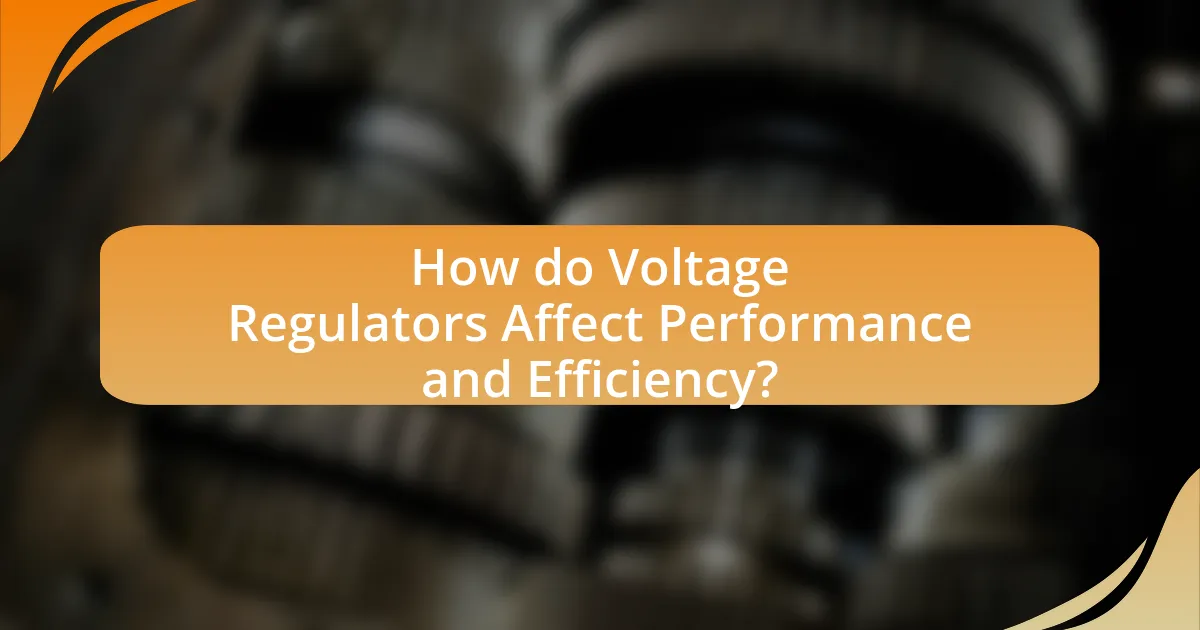
How do Voltage Regulators Affect Performance and Efficiency?
Voltage regulators significantly enhance performance and efficiency by maintaining a stable output voltage, which is crucial for the optimal operation of electrical components in high-performance vans. By ensuring that the voltage supplied to sensitive electronic systems remains within specified limits, voltage regulators prevent fluctuations that can lead to component failure or inefficiency. For instance, a study by the IEEE on automotive power systems indicates that stable voltage levels can improve the reliability of electronic control units, thereby enhancing overall vehicle performance. Additionally, efficient voltage regulation minimizes energy loss, which contributes to better fuel efficiency and reduced emissions, aligning with modern environmental standards.
What impact do voltage regulators have on engine performance?
Voltage regulators significantly impact engine performance by ensuring a stable voltage supply to the vehicle’s electrical systems. A consistent voltage level prevents fluctuations that can lead to erratic engine behavior, reduced fuel efficiency, and potential damage to electronic components. For instance, when voltage regulators maintain optimal voltage levels, they enhance the performance of fuel injectors and ignition systems, which are critical for efficient combustion. Studies have shown that vehicles with properly functioning voltage regulators experience improved throttle response and overall engine efficiency, as the electrical systems operate within their designed parameters.
How does voltage regulation influence fuel efficiency?
Voltage regulation directly influences fuel efficiency by ensuring that the electrical system operates at optimal voltage levels, which reduces energy waste. When voltage is regulated effectively, the engine management system can function more efficiently, leading to improved combustion and reduced fuel consumption. For instance, a study by the Department of Energy found that maintaining voltage within a specific range can enhance the performance of fuel injectors and ignition systems, resulting in up to a 10% increase in fuel efficiency in high-performance vehicles. This demonstrates that proper voltage regulation is crucial for maximizing fuel efficiency in high-performance vans.
What are the effects of voltage fluctuations on engine components?
Voltage fluctuations can lead to significant damage to engine components, including electrical systems, sensors, and control units. These fluctuations can cause overheating, premature wear, and failure of critical components such as the alternator and battery. For instance, a study by the Society of Automotive Engineers indicates that voltage spikes can exceed the tolerance levels of electronic control units, resulting in malfunctions or complete failure. Additionally, inconsistent voltage can disrupt the operation of fuel injectors and ignition systems, leading to poor engine performance and increased emissions.
How can voltage regulators improve the lifespan of electrical systems?
Voltage regulators enhance the lifespan of electrical systems by maintaining a stable output voltage, which prevents overvoltage and undervoltage conditions that can damage components. By ensuring that the voltage supplied to sensitive electronic devices remains within specified limits, voltage regulators reduce the risk of overheating, electrical stress, and premature failure. For instance, studies show that consistent voltage levels can extend the operational life of capacitors and semiconductors, which are critical in high-performance electrical systems. This stability is particularly vital in high-performance vans, where fluctuating voltage can lead to significant wear and tear on the electrical infrastructure.
What are the signs of a failing voltage regulator?
The signs of a failing voltage regulator include fluctuating voltage levels, dimming or flickering lights, and electrical component malfunctions. When the voltage regulator fails, it can no longer maintain a consistent voltage output, leading to these symptoms. For instance, if the vehicle’s lights dim or flicker while driving, it indicates that the voltage regulator is not supplying stable power. Additionally, if electronic components such as the radio or dashboard instruments behave erratically, this further suggests a malfunctioning voltage regulator. These signs are critical indicators that should prompt immediate inspection and potential replacement of the voltage regulator to prevent further electrical issues in high-performance vans.
How can proper voltage regulation prevent electrical failures?
Proper voltage regulation prevents electrical failures by maintaining a consistent voltage level, which is crucial for the reliable operation of electrical components. When voltage levels fluctuate outside of specified limits, it can lead to overheating, component damage, or complete system failure. For instance, a study by the Electric Power Research Institute indicates that voltage sags and spikes can cause significant disruptions in electrical systems, leading to costly downtime and repairs. By ensuring that voltage remains stable, voltage regulators protect sensitive electronics in high-performance vans, thereby enhancing overall vehicle reliability and performance.
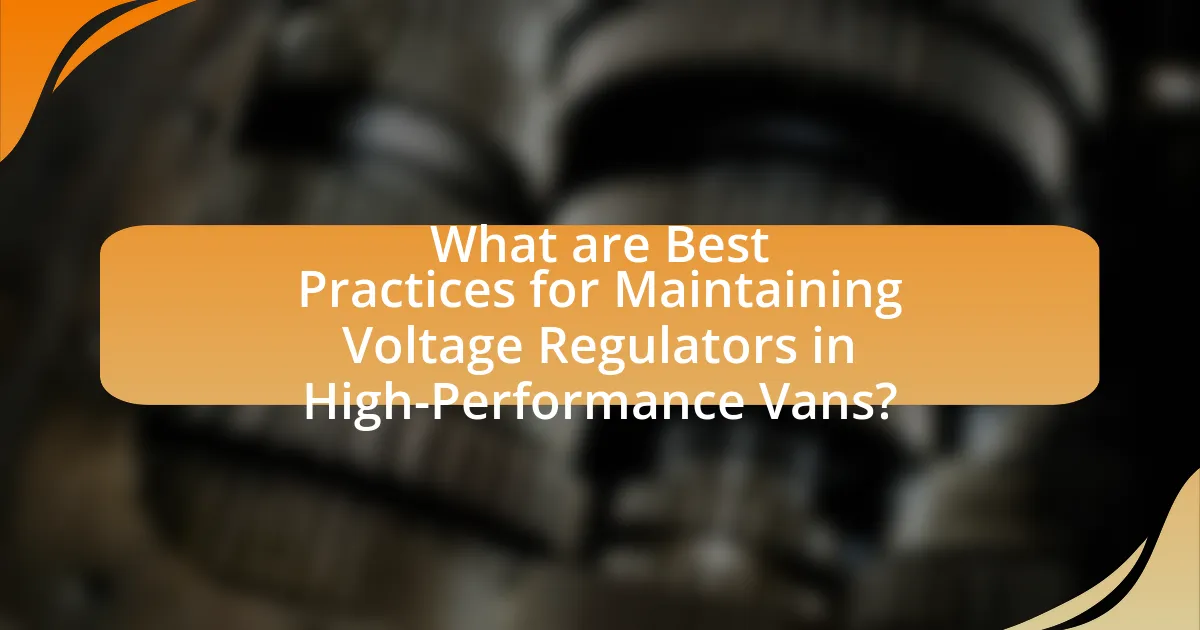
What are Best Practices for Maintaining Voltage Regulators in High-Performance Vans?
Best practices for maintaining voltage regulators in high-performance vans include regular inspections, ensuring proper connections, and monitoring voltage output. Regular inspections help identify wear or damage, while ensuring proper connections prevents voltage drops and overheating. Monitoring voltage output ensures that the regulator operates within specified limits, which is crucial for the performance of high-performance vans. According to automotive maintenance guidelines, maintaining voltage regulators can extend their lifespan and improve overall vehicle reliability.
How can owners ensure optimal performance of voltage regulators?
Owners can ensure optimal performance of voltage regulators by regularly maintaining and monitoring their systems. This includes checking for proper connections, ensuring adequate cooling, and replacing worn components. Regular maintenance prevents overheating, which can lead to failure, and monitoring voltage levels helps identify issues before they escalate. Studies indicate that consistent maintenance can extend the lifespan of voltage regulators by up to 30%, thereby enhancing overall system reliability and performance.
What routine checks should be performed on voltage regulators?
Routine checks on voltage regulators should include verifying output voltage levels, inspecting for physical damage, and testing for proper heat dissipation. Ensuring that the output voltage levels are within specified limits is crucial for the regulator’s performance and the overall electrical system’s stability. Physical inspections should focus on identifying any signs of wear, corrosion, or damage that could affect functionality. Additionally, testing for adequate heat dissipation is essential, as overheating can lead to failure; this can be assessed by checking the temperature of the regulator during operation. Regularly performing these checks helps maintain the reliability and efficiency of voltage regulators in high-performance vans.
How often should voltage regulators be replaced or serviced?
Voltage regulators should typically be replaced or serviced every 3 to 5 years, depending on usage and environmental conditions. Regular inspections are essential, as factors such as high temperatures, humidity, and electrical load can accelerate wear. For instance, manufacturers often recommend checking voltage regulators during routine maintenance to ensure optimal performance and prevent potential failures.
What troubleshooting steps can be taken if voltage regulators fail?
If voltage regulators fail, the first troubleshooting step is to check the input voltage to ensure it is within the specified range. Voltage regulators require a stable input voltage to function correctly; if the input voltage is too high or too low, the regulator may not operate properly. Next, inspect the output voltage to confirm it meets the required specifications. If the output voltage is outside the acceptable range, the regulator may be defective. Additionally, examine the connections and wiring for any signs of damage or corrosion, as poor connections can lead to voltage regulation issues. Finally, test the voltage regulator with a multimeter to determine if it is functioning as intended; if it fails the test, replacement is necessary. These steps are essential for diagnosing and resolving voltage regulator failures effectively.
How can you diagnose issues with voltage regulators?
To diagnose issues with voltage regulators, first measure the output voltage using a multimeter to ensure it matches the specified voltage range. If the output voltage is too high or too low, it indicates a malfunction. Additionally, inspect the regulator for physical damage, such as burnt components or corrosion, which can affect performance. Testing the input voltage to the regulator is also crucial; if it is outside the acceptable range, the regulator may not function correctly. Furthermore, checking for overheating can reveal internal failures, as excessive heat often leads to regulator failure. These diagnostic steps are essential for identifying and resolving voltage regulator issues effectively.
What common repairs can be performed on faulty voltage regulators?
Common repairs for faulty voltage regulators include replacing damaged components such as capacitors, diodes, and transistors. These components often fail due to overheating or electrical surges, leading to voltage regulation issues. For instance, a faulty capacitor can cause voltage fluctuations, while a damaged diode may prevent proper current flow. Repairing these components restores the voltage regulator’s functionality, ensuring stable voltage output essential for high-performance vans.
